
Do you have pots that stand empty for weeks out of the year? In northern climates, gardeners often empty and clean their pots in winter. Since unglazed ceramic pots absorb water and sometimes crack in freezing temperatures, this makes sense. But how empty things must look once summer’s beautiful pots go into storage.
Fourth Dimensional Gardening
Gardeners work in four dimensions. Of course we consider how tall a plant will grow and how deep its roots will go. Every plant grows to a certain width and depth to fill the space around it. But we also work in a fourth dimension: time. Each plant appears, grows, and fades according to its own schedule. We can use this to our advantage, planning for various plants to appear in their season, dovetailing to create a series of beautiful compositions during each gardening year.
Our coastal Virginia remains mild enough to enjoy our pots throughout the year. With a little planning, a gardener can have a beautiful display, and maybe even something in bloom, every week of the year. Once you have the right sort of pot positioned in a sheltered spot, your horticultural imagination is free to experiment with a range of beautiful plants.

Choosing Your Container
Of course, everything depends on having the proper pot. There are three things to consider in choosing a pot that will remain planted year-round. First, the pot must be large enough to accommodate an assortment of plants, and their roots. Unless you have taken a large potted arrangement apart, you might not realize that many plants fill more volume below the soil level than above.
If you plan to use spring flowering bulbs in the arrangement this is particularly important. Each bulb looks small when you plant it. The roots will grow throughout winter and early spring, when you aren’t even thinking about it.
If you plant to anchor your arrangement with a small shrub, choose the shrub before choosing the pot. You will need space for the shrub’s roots, plus space for the other bulbs or plants you want under and around it. Buy the largest pot you can reasonably afford that will fit your space.
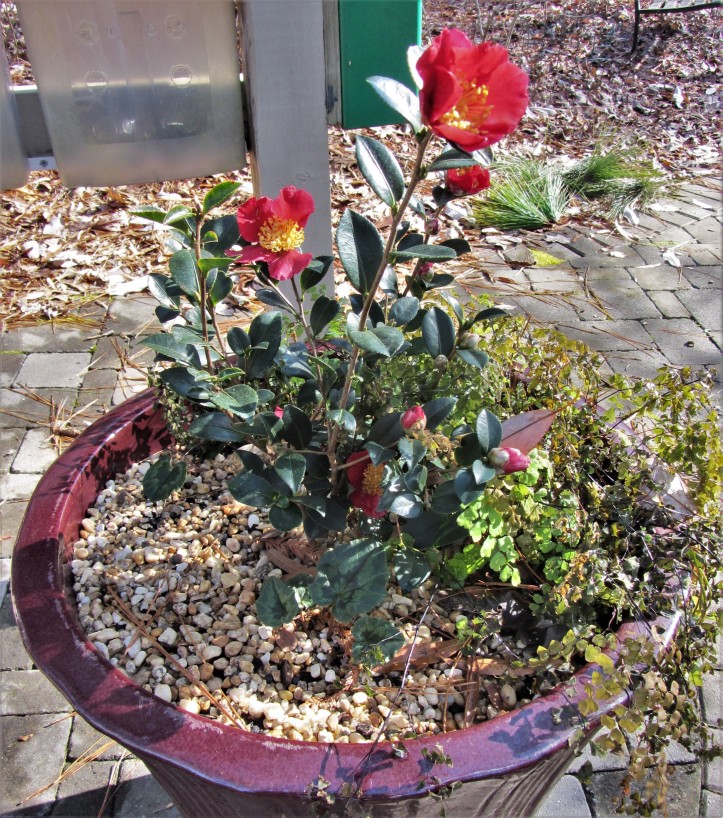
Make sure your pot allows the soil to drain. If your container doesn’t come with drainage holes, you will want to drill several before adding soil. Remember that water expands when it freezes. If you have freezing weather at all, you will want free-draining soil in your arrangement.
And finally, consider what a pot is made from. Some ceramic pots are designed to withstand freezing temperatures, and some may have a sticker telling you what temperatures they can withstand. Most glazed ceramic pots will stand up to many winters with no problems. But these pots are very heavy before you ever add soil or plants. Should you need to move the pot after it is filled, you may have a real challenge.
Resin pots may look like concrete and are made of a weather resistant synthetic material. They are lightweight and durable. Plastic pots are also lightweight but may not be as attractive. Plastic breaks down after several years out in the weather and will need to be replaced in a few years.
Half barrels provide plenty of planting space. If yours is wooden, consider stapling a plastic leaf bag just below the rim to line it. Cut some drainage holes in the bottom of the bag. The plastic protects the wood from rot and helps conserve moisture in the potting mix.
You can make your own hypertufa concrete based pots, and you can use a variety of re-purposed items, like metal buckets or watering troughs available at some farm supply or hardware stores.
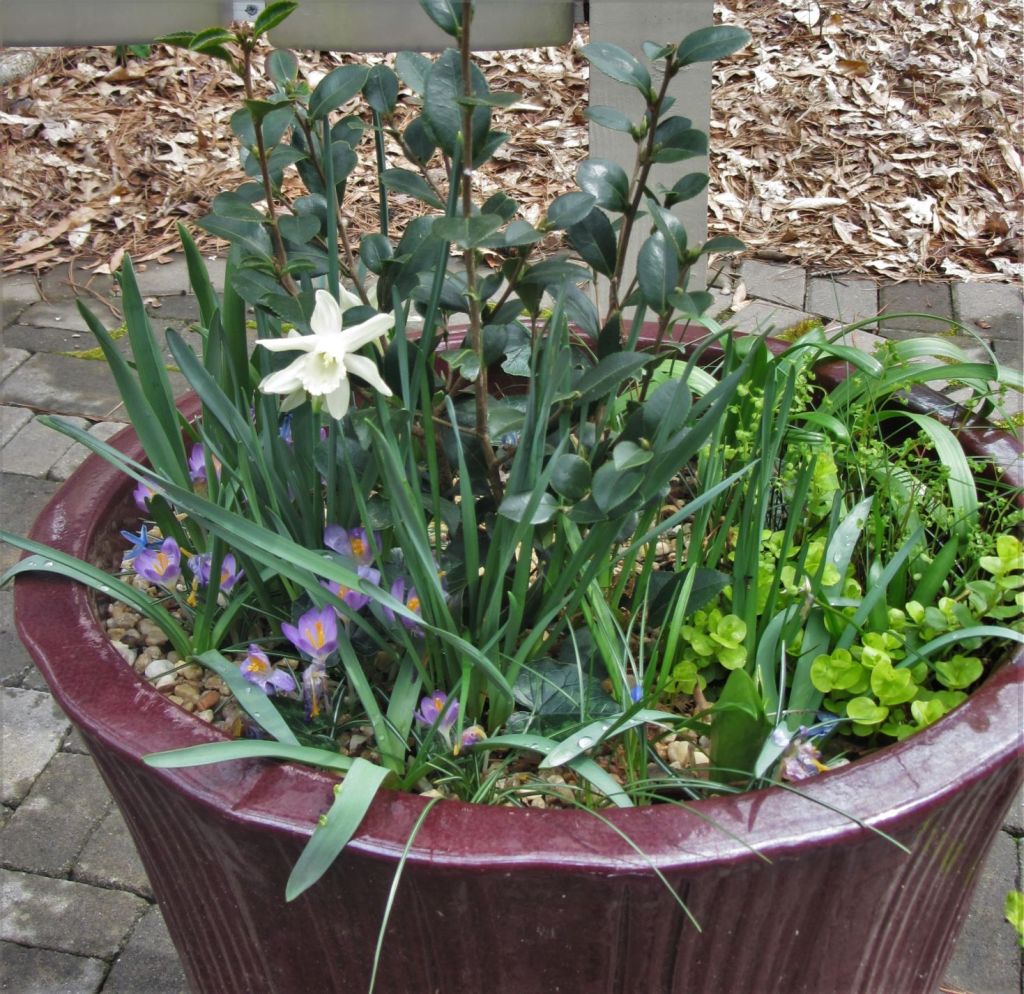
Choose a sunny but sheltered spot where you will pass by often enough to enjoy your four-season arrangement. Make sure this is a spot where it will be easy to water and care for the arrangement. The final choice of pot will depend on the available space and how it will look near your home. Place large pots before filling them with soil, as they will be heavy once you finish them.
Mixing Your Soil
Some container gardeners suggest filling the bottom of large pots with odd objects that fill space and reduce weight. Since you will leave this arrangement together for several years, while the plants continue growing, I recommend filling the entire volume of the pot with growing medium. That doesn’t mean it all needs to be expensive potting soil, however.
You might fill the bottom half of the pot with a mixture of commercial topsoil or compost and shredded bark. These will help feed your plants long-term, and the shredded bark will help reduce weight. Use commercial potting soil, possibly mixed with 1/3 shredded bark, in the top 12” of your pot, at least. As you fill the pot, also mix in some slow-release organic fertilizer to enrich the soil. I use Espoma’s Bio-Tone because it helps bring the soil to life with beneficial microbes and provides a wide range of micro-nutrients.
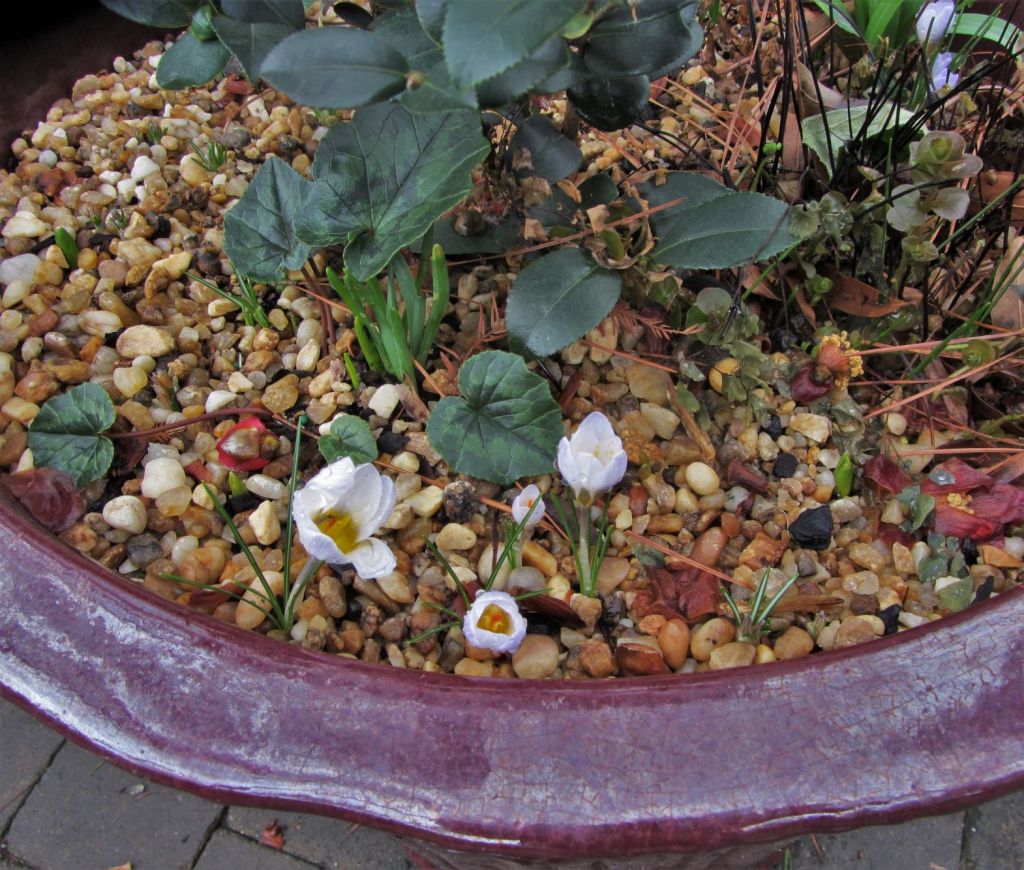
Planning and Planting
If you are using a shrub as the anchor plant, then fill the pot only deep enough that you can set the potted shrub on the soil and have its crown an inch to an inch and a half below the rim of the pot. Water the soil to settle it before beginning to plant, and adjust the soil level so the shrub won’t be too deep.
As you begin to plan what will grow in your four-season pot, it may be helpful to sketch a chart on graph paper to show which plants will be active when, and for how long. Make a timeline showing all 52 weeks of the year, divided into months.

Shade in a row under your timeline for each type of plant you want in your pot. For example, if you use an evergreen holly fern, which is beautiful year-round, you’ll shade in a solid line that spans the entire year. If you intend to plant daffodils, shade in a line that begins in February or March and ends by May. Since you can plant early, mid-spring or late daffodils, you might even shade in when you expect them to be in bloom. Do this for all the bulbs you expect to plant, including those that bloom in summer, late winter or fall.
As you sketch in the period of interest for each plant, you ‘ll begin to notice ‘gaps’ where you may want to add some annuals or tender perennials. This helps with plant selection and with planning how much space is required to grow what you want to grow.
If you want a long season of spring flowers from bulbs, then choose a few bulbs that bloom very early, like Crocus, some that bloom in mid-spring, and others that bloom in late spring and early summer. These early flowers help support early pollinators before many other flowers appear. Scilla is an especially good early flower for wildlife. Bulb catalogs are the best reference for when different flowers bloom.

Plant a bulb at 3 times its depth. A 2” bulb should be planted 6” deep. That means that the base of the bulb sits 6” below the surface of the soil. Larger bulbs go deeper, and smaller bulbs are planted nearer to the surface. This is the secret for packing a lot of bulbs into a pot. Think of it like assembling a cake of several layers and fillings.
First, remove any shrub or perennial that will anchor your arrangement from its nursery pot, loosen up any tangled roots at the bottom of the root ball, and rough up the sides to loosen any roots ‘stuck’ to the sides of the root mass. This encourages the roots to grow out into the new soil. Place it in the pot on top of the soil so its ‘crown’ is at the right level about an inch below the rim of the pot. Fill in around the root ball with just enough potting soil to bring the depth to the right level for your largest bulbs.
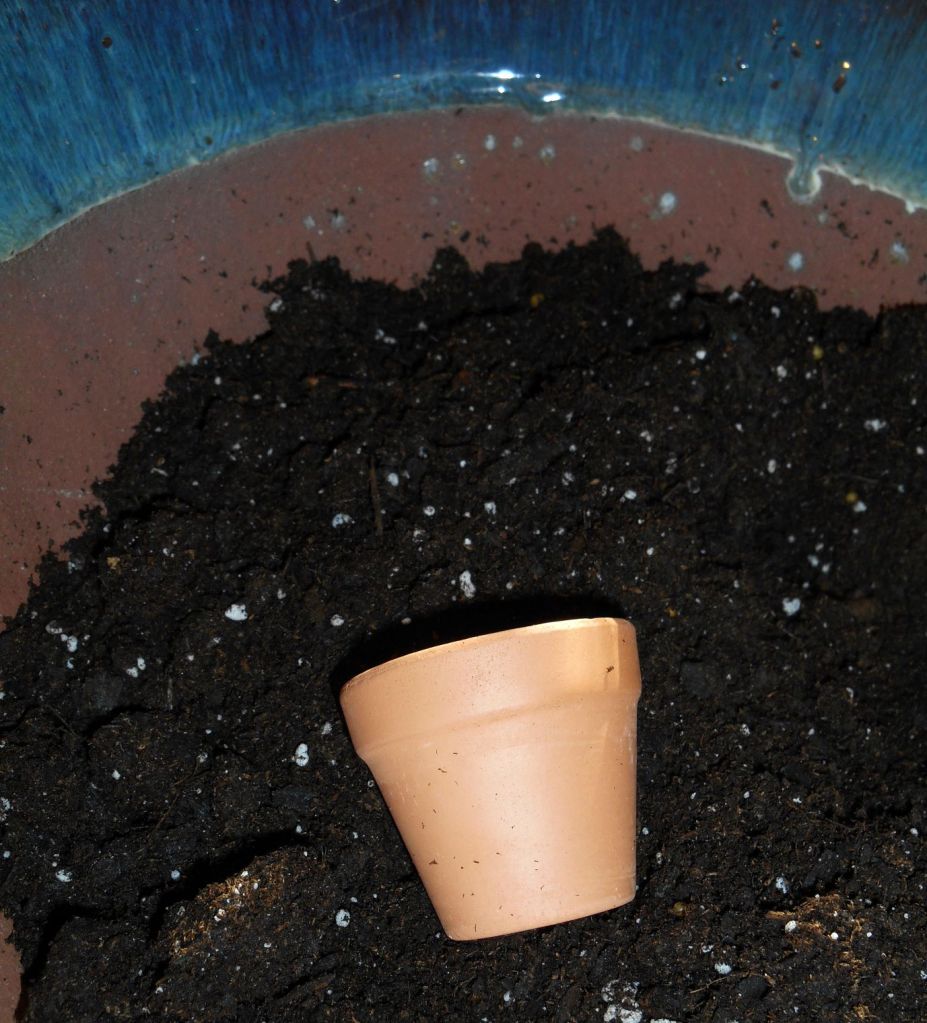
After placing the largest bulbs around the roots of your anchor plant, add just enough soil on top of them to bring the level to the right depth for the next bulbs you intend to plant. Continue until all bulbs are planted, leaving spaces between the top bulbs for any other plants you will include.
Finally, add additional plants such as herbs, annuals or vines to add to the arrangement. Tuck them in place, and then mulch the arrangement with pea gravel, aquarium gravel, more shredded bark mulch, or moss.

The evergreen anchor plant and bulbs will remain in place year-round for as long as they fit your pot. You might choose evergreen vines to soften the pot, and winter blooming annuals, like Violas for color in the fall and again in the spring. You’ll probably want to replace these with something else in April or May.
Alternatively, you might enjoy a pot finished in mosses through the winter, with bulbs appearing in the spring. You will probably find new plants to try over the years.

Here are a few suggested four-season container plants:
Anchor plants:
These plants will have a ‘presence’ year-round and will be the largest plants in your container.
Evergreen Shrubs: (Plant shrubs hardy to at least one growing zone colder than where you live because the cold will affect them more in pots than in the ground.)
Camellia japonica or Camellia sasanqua; Mahonia (now Berberis) species, Ilex (holly) species, Picea glauca ‘Conica’ (dwarf Alberta spruce), Osmanthus ‘Goshiki’, Osmanthus fragrans (tea olive), Salvia rosmarinus (rosemary herb)
Deciduous Shrubs/Trees: Choose trees that bloom in early spring
Cercis canadensis (redbud), dwarf peach, cherry or plum trees, Forsythia, Acer palmatum, (Japanese maple)

Evergreen Perennials: (Choose plants hardy to at least one growing zone colder than where you live because the cold will affect potted plants more than those planted in the ground.)
Helleborus species and cultivars (year-round green leaves, some variegated or patterned, and winter flowers)
Heuchera hybrids (native coral bells bloom in early summer)
Arum italicum (green leaves appear in October and remain green until June. Blooms in April or May)
Ajuga reptans cultivars (bugleweed remains evergreen and blooms in mid-spring)
Antirrhinum majus, (snapdragon- foliage may wither, but will revive in early spring)
Saxifraga stolonifera (strawberry Begonia) forms a dense groundcover and will bloom in late spring
Ophiopogon japonicus (mondo grass)
Sedum species (there are many colorful Sedums that hold their color and form all winter. Most are low growing, under 5″ tall, and make good groundcover.

Evergreen Ferns: Cyrtomium species (Japanese holly fern), Dryopteris erythrosora cultivars (Autumn fern ‘Brilliance’), Polystichum acrostichoides (native Christmas fern), Polystichum polyblepharum (Asian tassel fern)
Ephemeral Plants
These perennials will support the anchor plants. Most will appear and disappear according to the seasons
Deciduous Ferns: Deciduous ferns appear in the spring and drop their leaves in late fall or early winter. These hardy perennials make a nice back drop for emerging spring bulbs, and then continue growing new fronds throughout the warm season. Use them like any other perennial. Most want partial to full shade and consistently moist soil to thrive.
Adiantum species (maidenhair ferns), Athyrium species (lady ferns, including Japanese painted ferns), Dryopteris species (wood ferns), Onoclea species (sensitive fern)

Vines: Perennial vines are considered invasive in many areas. If you grow these in pots, don’t let them root in the surrounding area because they will crowd out other plants.
Mitchella repens (native partridgeberry)
Hedera helix (English ivy not native)
Euonymous fortune (wintercreeper not native)
Vinca minor (periwinkle not native)
Lysimachia nummularia (Golden yellow-green creeping Jenny may turn red in cold weather. It is very invasive if it escapes from its pot)
Herbs: Perennial herbs often grow into woody shrubs over several seasons. Prune them back in late summer to allow for new spring growth. Rosemary often blooms in fall in winter and remains very green and vibrant in cold weather. Thyme and lavender may take a few weeks of dormancy in the coldest part of winter but will show new growth in spring. Choose herbs at least one growing zone colder than where you live.)
Rosemary, thyme, culinary sage, lavender, germander, curry, santolina, fennel, dill, winter savory, lemon verbena, lemon balm
Parsley is a biennial. It will overwinter the first year and show growth in early spring. Replace it after it blooms in the second year. Cilantro and basil are annuals and may be planted in the spring.

Spring blooming bulbs: Most bulbs bloom for a week or two, then their flowers fade. Foliage appears weeks before the flowers and lasts for a month or two after the flowers fade. Plan to leave the foliage until it turns brown and wilts, to fuel the bulbs for next spring’s flowers.
Early: Galanthus species (snowdrops), Crocus species, Cyclamen coum, Iris (dwarf species), Muscari species (grape hyacinth),
Middle: Narcissus species (daffodils), Erythronium species (dog-tooth violet), Fritillaria species, Hyacinthoides species, Hyacinthus orientalis (Hyacinth), Iris (Dutch hybrids), Scilla species,
Late: Anemone blanda, Anemone coronaria, Ipheion uniflorum (star flower), Leucojum (snowflake), Tulip hybrids and species
Summer blooming bulbs: Oxalis (shamrock), Caladium (elephant ears), Allium species, Begonia species and hybrids, Dahlia species, Iris species and hybrids, Liatris, Lycoris species (naked ladies or spider lily), Zantedeschia species (calla lily)
Fall bulbs: Cyclamen hederifolium, Arum, Colchicum species(fall Crocus)
Annuals and Perennials to fill in the gaps:
Violas/pansies, Dianthus, Columbine, Begonias, Coleus, Hosta, and so many more…. Use what makes you happy!
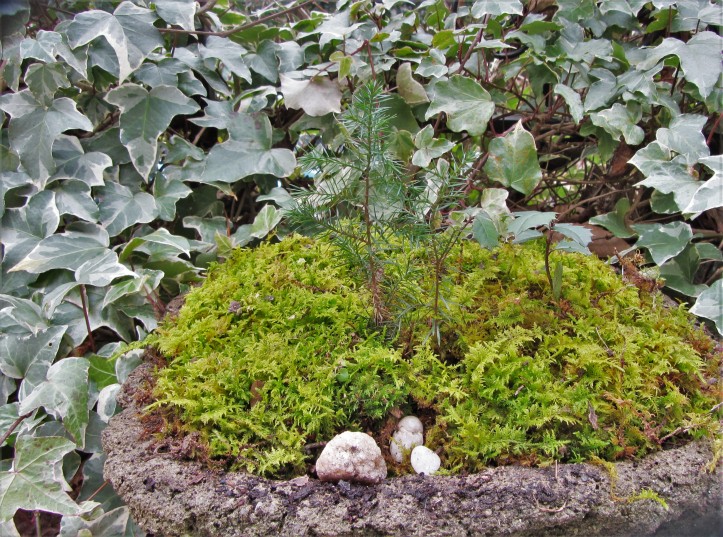
You will find several good books and pamphlets about four season gardening. Brent Heath gives workshops on planting bulbs in layers at his Brent and Becky’s Bulbs shop in Gloucester, Virginia, and I have described his technique in this post.
Find more information here: Fourth Dimensional Winter Pots at Forest Garden 2017
I do not mean to change the subject, but the beautyberry seedlings and butterfly ginger arrived yesterday and got picked up today. I should get to my email to tell you about it tomorrow. Thank you SO much!
LikeLiked by 1 person
You are very welcome! I have been worried about the seedlings and hope they made it to you in good shape. The Windmill palms were Gorgeous when they arrived and they are happily adjusting to life in Virginia. Thank you!
LikeLiked by 1 person
You are welcome. They will be happier there than they would have been here.
LikeLiked by 1 person
Same for your beautyberry! The squirrels have been digging around the area where I keep seedling trees. I had to replant several pines and two figs yesterday morning. Animal repellents haven’t been sufficient to keep them away these last few weeks. So your seedling beautyberries are saved from Virginia squirrels. I won’t even tell you what would have happened to the branches you are going to root….
I’m going to move the palms out of their partial shade into a sunnier spot today, and remove them from the bin. They have had a few days now to settle into their new pots. My cat likes to go sun himself beside them.
LikeLiked by 1 person
Kitty might be imagining the beach in Malibu, although those palms are different.
LikeLiked by 1 person